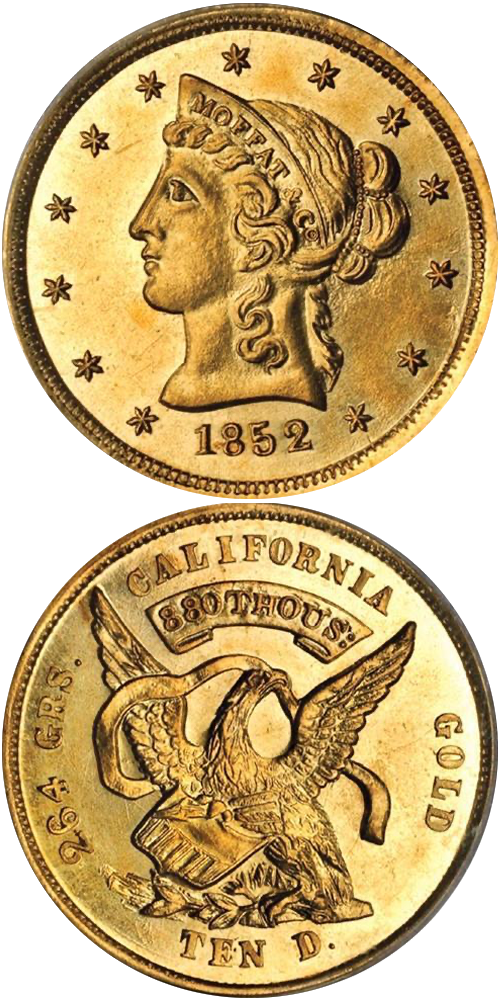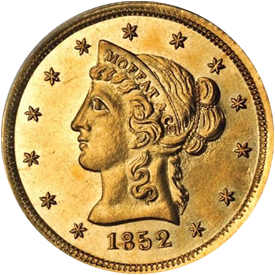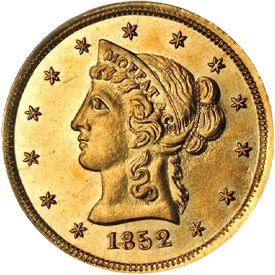Moffat & Co., while not the first coiner of gold in California, became the most important private mint in San Francisco. At a time when the coinage of other assayers, bankers, and minters was being seriously questioned, the issues of Moffat were readily accepted by merchants. Later, the facilities of the firm were incorporated into the San Francisco Mint.
A biographical sketch of John Little Moffat was provided to Edgar H. Adams by R. Burnham Moffat, of New York City, a grandson who in 1909 published the Moffat Genealogies:
John Little Moffat at the age of twenty-three years married Hannah Curtis, daughter of Reuben Curtis, of Danbury, Connecticut. Fourteen children were born to them, but only five survived infancy, and but three of those five married and had issue. Mr. Moffat lived in New York City from his marriage until about the middle of the 'thirties, when he moved to northern Georgia, in the valley of the Nacoochie, where he had purchased some gold mines which he had begun to operate. He had previously owned a gold mine in North Carolina, and on three separate occasions during his life made, and as many times lost, what in those days was deemed a very considerable fortune. In his youth he learned the trade of a silversmith, and throughout his life found satisfaction in the thought that he "had a trade." Lack of persistence seems to have been the defect in what otherwise was a character of high purpose, charm, and manly lovableness. He was identified in turn with the Presbyterian, Episcopalian, Dutch Reformed, Quaker, Methodist, and Swedenborgian faiths, but found the satisfaction he sought in none of them — except possibly the last, with the teachings of which he became familiar during the closing years of his life.
When the gold fever fell upon the country, following the discovery of gold in California, it found Mr. Moffat at the bottom of one of his waves of financial success, and he joined the throng of "forty-niners." While in California he became Assayer for the United States Government, and during the few years of his stay there established a reputation for unswerving integrity in the assaying of gold, which survived, for many years, his return to the East. He died in Brooklyn, New York, at the home of his son. Dr. Reuben Curtis Moffat on June 19, 1865, at the age of seventy-seven years, idolized by his daughter and surviving sons.
Moffat, born in Goshen, New York on February 12, 1788, was in his early sixties when he joined the California adventurers. The New York Tribune on February 14, 1849, told of his departure from that city:
The good bark Guilford sails today from the foot of Wall Street. Whatever success may attend the various adventurers, associated or individual, they will require a certain medium of circulation, or a fixed standard for their gold-dust. This end may be obtained through the operations of Messrs. Moffat & Co., who go out in the Guilford, with proper assistance, and most complete machinery and apparatus, to supply the want of Californians; in other words, to establish a sort of mint, to receive the gold-dust, smelt and assay it, and by their stamp to give it a currency and value, which must, in the absence of a Government character, be received by the merchants and consumers.
Mr. John L. Moffat, known as the standard assayer in this city for many years, carries with him testimonials of our most eminent merchants, bankers, and bullion dealers, including a certificate of the strongest character from Messrs. Beebee, Ludlow & Co., the heaviest bullion dealers in the United States; the most eminent gold dealers in the city, together with Hon. R.J. Walker, Secretary of the Treasury, have endorsed the circular of Messrs. Moffat & Co. They have our best wishes for their success.
Moffat, who in New York was associated with the firm of Wilmarth, Moffat & Curtis, began business in San Francisco in the summer of 1849. Associated with him were Joseph R. Curtis, P. H. W. Perry, and Samuel H. Ward. Their office at Clay and Dupont streets was busy with the activity of trading in gold dust, refining it and converting the metal to bars and ingots to ship to the East for sale. An advertisement of the time read:
MOFFAT & CO.
John L. Moffat, Joseph R. Curtis, S.H. Ward, P.H. Perry, have erected suitable furnaces, and are provided with all the necessary apparatus and most ample facilities for smelting and assaying Gold Dust.
The highest market price paid for Gold Dust.
They refer to the annexed testimonials from the most eminent Bankers, Merchants, and Bullion Brokers, of New York, the originals of which, with other evidences of character, may be seen at their office...
Then followed testimonials from various bankers and others, including R.J. Walker, secretary of the United States Treasury.
Moffat produced small rectangular gold ingots ranging in value from $9.43 to $264. Most were of the value of $16. These are believed to have been first issued in June or July 1849.
The engraver Albert Kuner, who arrived in San Francisco on July 16th, was employed by Moffat & Co. Dies for a $10 issue were cut shortly thereafter. When Mr. Kuner's personal effects were examined following his death, an impression in wax of a Moffat & Co. undated $10 was found, accompanied by a note stating that the impression had been taken on July 31, 1849, and was for Moffat's first coin. The piece in question resembled a United States government $10 but had legends referring to Moffat & Co. The reverse was inscribed S. M. V. CALIFORNIA GOLD, "S. M. V." meaning "standard mint value."
Shortly after $10 pieces made their appearance, a Moffat $5 coin, also engraved from dies cut by Kuner, reached circulation. In the following year, 1850, only pieces of the $5 denomination were made.
In September 1850 Congress authorized the Secretary of the Treasury to contract with a well-established assaying business in California to affix the stamp of the United States to bars and ingots:
The Secretary of the Treasury ... be authorized and directed to contract, upon the most reasonable terms, with the proprietors of some well-established works now in successful operation in California, upon satisfactory security, to be judged by the Secretary of the Treasury, who shall, under the supervision of the United States Assayer, to be appointed by the President by and with the advice and consent of the Senate, perform such duties in assaying and fixing the value of gold in grains and lumps, and forming the same into bars, as shall be prescribed by the Secretary of the Treasury; and that the said United States Assayer shall cause the stamp of the United States, indicating the degree of fineness and value, to be affixed to each bar or ingot of gold that may be issued from the establishment; provided, that the United States shall not be held responsible for the loss of any gold deposited with said proprietors for assay.
Moffat & Co. received the honor. Appointed to the position of United States Assayer was Augustus Humbert, a New York City maker of watch cases. Information concerning Augustus Humbert and the subsequent United States Assay Office of Gold appears earlier in the present catalogue.
Moffat & Co. ceased their private business and prepared to issue coins under the government contract. New premises were secured on Montgomery Street between Clay and Commercial streets.
Following the issuance of large $50 slugs by Moffat-Humbert, there developed a great shortage of smaller pieces in circulation. Hardships were experienced by many merchants.
In December 1851 the partnership interests in Moffat & Co. were changed. On the 24th of that month the Daily Alta California carried this notice:
Co-partnership noted. The firm heretofore known and existing under the name and style of Moffat & Co. is this day dissolved by mutual consent, the entire interest of the special partner, John L. Moffat, having been purchased by the remaining partners, who have the right to use the name of Moffat & Co.
The declaration was signed by John L. Moffat, Joseph R. Curtis, Samuel Ward, and Philo H. Perry. It was further stated that "the firm will hereafter consist of the undersigned remaining partners, and its business until further notice will be conducted under the name and style of Moffat & Co." The addendum was signed by Curtis, Perry, and Ward.
On December 31,1 851 Augustus Humbert, the United States Assayer in California, without having seen the correspondence earlier in December, wrote to Hon. Thomas H. Corwin, secretary of the Treasury, in Washington, D.C. and noted that the situation demanding smaller denominations was becoming acute.
Accompanying this Messrs. Moffat & Co. send you the monthly report of the transactions of this office, showing a sad falling off in its business, not to say its usefulness; it is an incontestable fact that the great scarcity of small coin (say, 5s, 10s, and 20s) has its influence, for in the greater portion of the transactions of the country the $50 ingots are too large, even the bankers have to restrict their depositors to checking for round amounts, or submit to a serious loss, as they are obliged to pay from 1 1/2% to 2% premium on the small coin necessary for their daily transactions, thus showing the urgent necessity existing for the issue of ingots of smaller denomination than 50s from this office.
Several of our most influential merchants and bankers as a matter of absolute necessity, not choice, have been urging somebody to make small coin with a private stamp, and I understand the dies are already in the hands of the engraver; whether or not these dies will be used will probably depend on the decision you may have taken with regard to the application presented to you by Mr. J. R. Curtis, etc. I sincerely hope it will be favorable and soon at hand, as I am well satisfied that if private coin again resumes the place it once had among us, the door will be open for greater frauds than was before perpetrated.
On January 15, 1852 two letters from the Treasury reached Moffat: one authorizing the coinage of smaller denominations, and one rescinding the authorization written the following day.
Early in the month Moffat had received a petition signed by over 50 leading San Francisco merchants and citizens urging them to strike smaller denominations. Finally in response to this request, and recognizing the futility of the request made to the government for an official coinage of small denominations, Moffat & Co. issued $10 pieces around the middle of January 1852. A contemporary newspaper account dated January 14th noted that "Messrs. Moffat & Co., and Wass, Molitor & Co. have again commenced to issue small coins."
In February 1852 the Treasury Department commission to make smaller denominations was received, so Moffat announced its intention to discontinue coinage bearing the Moffat & Co. name: No more coin will be manufactured bearing the stamp of Moffat & Co., and that already issued will be redeemable whenever demanded."
In 1853 a $20 piece bearing the name of Moffat & Co. appeared. The design, except for the inscriptions, was quite similar to that of the current United States double eagle being struck at Philadelphia. Notice concerning the new issue appeared in the Daily Alta California on July 26, 1853:
Moffat & Co.'s Assay Office. The new double eagles lately issued by this firm are attracting much admiration for their beautiful workmanship. The coin is a facsimile of that struck by the United States Mint, with the head instead of bearing the motto LIBERTY has MOFFAT & CO. As regards design and finish, the piece is scarcely inferior to the issues of the Mint and reflects great credit upon Messrs. Moffat & Co.'s taste, enterprise, and artistic skill.
The reason for issuing a distinctive Moffat & Co. double eagle at the same time coins of identical denomination were being produced by the United States Assay Office of Gold, under the same management, is enigmatic.
In 1853 the properties of Curtis, Perry & Ward were incorporated into plans for the new San Francisco Mint. Part of the earlier coining establishment was utilized in the construction.
In its day Moffat & Co. enjoyed a reputation unequalled by any other private coining establishment.








